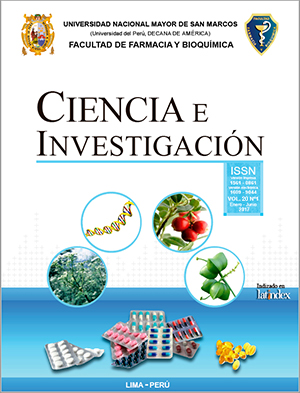Processing and nutritional chemical and technological evaluation of precoced product based pota (Dosidicus gigas)
DOI:
https://doi.org/10.15381/ci.v20i1.14318Keywords:
Pota, Dosidicus gigas, Chemical composition, pota derivativesAbstract
The squid (Dosidicus gigas) is a cephalopod mollusk, a source of high quality proteins that is currently underexploited. The objective was to develop the methodology for the elaboration of a pre-cooked pota product, to evaluate the digestibility of the proteins and the shelf life of the product. Methodology: In a descriptive and experimental design, the nutritional technological study was carried out. Two samples of squid each consisting of 5 kg of the mantle, acquired at the Callao Fishing Terminal, were processed and analyzed independently. The process flow included: disinfection, cutting, washing, stabilization, cutting into strips, cooking by immersion in vegetable oil, packaging and storage. The physical and chemical analysis, using AOAC techniques; minerals using GBC Avanta atomic absorption spectrophotometer with graphite furnace. The digestibility by enzymatic method. The sensory analysis, by descriptive method. The microbiological analysis, according to national and international criteria. The most relevant results (%) in the fresh sample and in the pre-cooked product were: water, 80,2g and 42,9g; 16g and 43,0g proteins; protein digestibility, 87 and 89% respectively. Lead and cadmium not detectable. According to taste and smell attributes, between 51 and 76% of the evaluation panel categorized the precooked product as “pleasant”. The useful life was 30 days. The microbiological analysis: Aerobic mesophiles; 2 x 10 cfu / g; E. coli absent; Staphylococcus aureus, absent; Salmonella sp in 25 g., Absent. The characteristics of the pre-cooked pota-based product show the nutritional potential of the squid for conserving the quality of the proteins and to be acceptable and innocuous.Downloads
Published
2018-02-22
Issue
Section
Artículos Originales
License
Copyright (c) 2018 Eloisa M. Hernandez F, Elena R. Benavides R., Norma A. Carlos C., Luis A. Inostroza R., Esmeralda Castillo, Úrsula Villafuerte, Javier Córdova, Nelson Bautista, Ana A. Alencastre M., María T. Peña L., Rosa Byrne

This work is licensed under a Creative Commons Attribution-NonCommercial-ShareAlike 4.0 International License.
LOS AUTORES RETIENEN SUS DERECHOS:
- Los autores retienen sus derechos de marca y patente, y tambien sobre cualquier proceso o procedimiento descrito en el artículo.
- Los autores retienen el derecho de compartir, copiar, distribuir, ejecutar y comunicar públicamente el articulo publicado en la Revista Ciencia e Investigación (por ejemplo, colocarlo en un repositorio institucional o publicarlo en un libro), con un reconocimiento de su publicación inicial en la Revista Ciencia e Investigación.
- Los autores retienen el derecho a hacer una posterior publicación de su trabajo, de utilizar el artículo o cualquier parte de aquel (por ejemplo: una compilación de sus trabajos, notas para conferencias, tesis, o para un libro), siempre que indiquen la fuente de publicación (autores del trabajo, revista, volumen, numero y fecha).
How to Cite
1.
Hernandez F EM, Benavides R. ER, Carlos C. NA, Inostroza R. LA, Castillo E, Villafuerte Úrsula, et al. Processing and nutritional chemical and technological evaluation of precoced product based pota (Dosidicus gigas). Ciencia e investigación [Internet]. 2018 Feb. 22 [cited 2024 Aug. 16];20(1):25-8. Available from: https://revistasinvestigacion.unmsm.edu.pe/index.php/farma/article/view/14318













